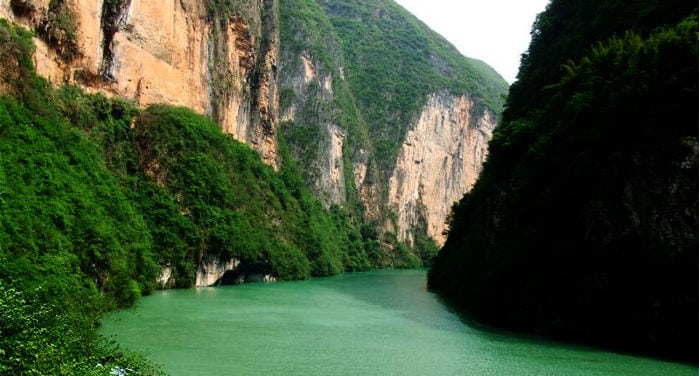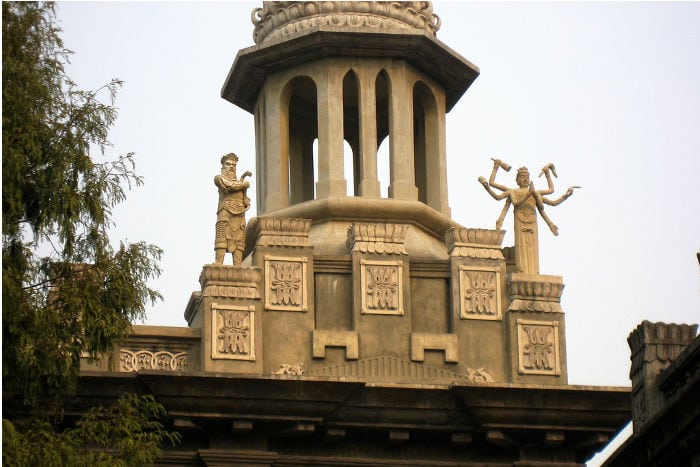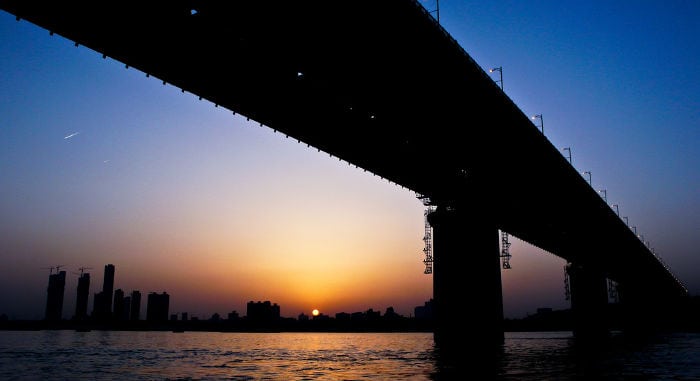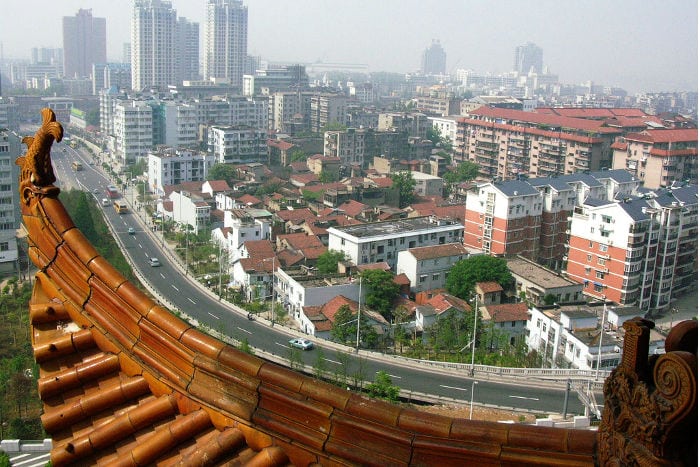
![]() Lesser Three Gorges Boat Trip032 by Paul B Doherty
Lesser Three Gorges Boat Trip032 by Paul B Doherty
Traveling to Hubei – Index
The capital of Hubei Province (湖北) is Wuhan (武汉). The abbreviated name for Hubei Province is 鄂 (E), a character mostly used on car license plates. The presence of the character 北 (bei) “north” shouldn’t fool you, since Hubei is a province in central China.
The name comes from the fact that it’s located north of the large and deep Dongting Lake (洞庭), just like Hunan (湖南) because, as opposed to Hubei, it’s located south of Dongting Lake. On one shore of Dongting Lake there’s the famous Yueyang Lou (岳阳楼), “Yueuang Tower”.
Note too that the really ancient State of Chu (楚) is located in Hubei.
Why visit Hubei Province?
Some time ago, the general image of China was a place full of lakes, rivers, mountains, forests, animals, Chinese with straw hats on board little boats, and so on.
Well, Hubei is certainly one of the most fertile and lush Chinese provinces, thanks to the countless rivers and lakes to be found there. The most important river that goes through Hubei is Changjiang (长江), the “Long River”, known in the West as the Yangzi or, Yangtze depending on the old phonetic transcription from Wade-Giles.
Although the literal translation of Changjiang is “Long River”, it’s conventionally called “Blue River” because there are clay-like substances present that allows it to reflect the blue of the sky like a mirror. The Changjiang is the longest river in Asia, and the third-longest in the world, surpassed only by the Amazon and Nile Rivers.
Although nature has an important role in Hubei, modernity has not failed to reach this wonderful province, with all the pros and cons that this brings.
Thanks to its central position – bordered by Henan (河南) to the north, Hunan (湖南) to the south, Anhui (安徽 ) to the east, Chongqing (重庆) to the west, Jiangxi (江西) southeast and Shaanxi (陕西) to the northwest, – Hubei is a strategic base for tourists to start exploring China and all its mysteries.
There’s something else that should be said: the Three Gorges start in Chongqing and end in Hubei. In fact, on May 20, 2006, in western Hubei – specifically in the city of Yichang (宜昌) – the famous Three Gorges Dam was completed, a dam for producing electric energy built on the Changjiang River (长江).
In any case, this geologic wonder of the Three Gorges is just a small wonderful introduction to the absolutely natural beauty of Hubei Province that, just to mention, boasts Wudang Shan (武当山), a small mountain chain rich in sacred mountains and pilgrimage sites for Taoists.
Keeping on the “nature” theme, in Hubei, there’s the large Shennongjia National Park (神农架), a UNESCO world heritage park, site of Shennongjia Linqu (神农架林区), or the “Shennongjia Forest District”.
Going back to Hubei’s position, the central nature of this province has given it a very important role in Chinese history: around the ancient city of Jingzhou (荆州) there are many traces of the now-vanished Chu Kingdom, of which there’s lots to say, especially regarding the religious beliefs of 2000 years ago.
Moreover, in the famous novel of the Three Kingdoms, there are several references to the city of Jingzhou. Staying on the historic theme, you can’t forget about the capital of Hubei, Wuhan. The present city of Wuhan, which is now a good 6,600,000 inhabitants, was the place where the revolt led by supporters of Sun Yat-sen (better known in China as Sun Zhongshan, 孙中山) began, which brought about the fall of the Qing Dynasty (清), in 1911, and the subsequent founding of the Republic of China, Zhonghua Minguo (中华民国).
Clearly, Wuhan offers a lot, and not just tourist attractions. To not get too far off of the Chinese language, not many know that at the University of Wuhan, Wuhan Daxue (武汉大学), there’s one of the best and well-known departments of classical Chinese language.
The residents of Hubei are generally called 九头鸟 (jiu tou niao), or “Nine-headed birds”: it’s rumored that the residents of Hubei like to twist the truth. But in my opinion, that’s a stereotype.
To conclude, besides the previously mentioned explanations, there’s a ton of reasons to visit Hubei. In this article, I’ll try to give as complete a picture possible of this marvelous place.
When to visit Hubei?
I’ll begin by responding to a common question: when is a good time to visit Hubei?
From March to April the temperature is still cool. The only inconvenience would be the unexpected rain; from September to November, when the summer heat has passed. The period between November and March is the best time to visit the Wudang mountain chain with its snowy peaks.
Every season has its own appeal, I only recommend that you watch out for the heat, especially if you have a hard time dealing with it!

![]() Statue on the apex by Yuxuan Wang
Statue on the apex by Yuxuan Wang
Wuhan – what’s there to see?
The capital of Hubei is the city of Wuhan, founded by the union of three cities: Wuchang (武昌), Hankou (汉口), and Hanyang (汉阳). Wuhan is also known as Jiusheng Tongqu (九省通衢), or “the main road of the nine provinces” but the reason behind this name isn’t clear.
There are two possible explanations:
- In classical Chinese, the number “nine” (九, jiu), didn’t exactly indicate a specific quantity, rather it was almost the equivalent of “many” (多, duo). In this case, a more appropriate translation would be “the main road of many provinces”, indicating how Wuhan was well connected with many provinces, not just nine;
- Or, the name comes from the fact that Wuhan, by land and sea, is connected with Sichuan, Shaanxi, Henan, Hunan, Guizhou, Jiangxi, Anhui, Jiangsu and Hubei, for a total of 9 provinces.
Wuhan, like all other major cities in China, is frighteningly large by our standards, but thanks to natural wonders like the aforementioned Blue River and the many lakes there, being in Wuhan is a very pleasant experience despite the numerous crowds. The Blue River almost flows through the center of the city, cutting the city in two and gifting mouthfuls of fresh and clean air.
Temples and pavilions
长春观 (Chang Chun Guan), the “Temple of the long Spring”
This is a large Taoist temple (all Taoist temples have the character 观, guan in its name) founded during the Han Dynasty. At the center of this temple, there’s 太清殿 (Tai Qing Dian) “the hall of Supreme Purity”, where there’s a beautiful statue of Laozi (老子) with a full white beard because in an unspecified past, Laozi – we can say the “progenitor” of Taoism – came to this temple to speak with his disciples.
归元寺 (Guiyuan Si), “Guiyuan Temple”
This is a Buddhist temple over 350 years old, still in perfect condition. Even if you’re not Buddhist, this is a place to visit for its majesty and magnificence. The most beautiful thing in this temple is perhaps a two-meter table sculpted with the image of Guanyin with a willow branch in hand, going back to the Tang Era.
Inside the temple, there’s also the Hall of the Arhat (those worthy of veneration) which contains about 500 statues of disciples who have reached illumination.
藏经阁 (Canjing Ge), the “Pavilion of the guarded sutra”
There’s a jade Buddha inside this pavilion. In my opinion, this “pavilion” looks more like a pagoda, but that isn’t important: it’s still a thrill to see!
黄鹤楼 (Huang He Lou), the “The Tower of the Yellow Crane”
This tower is situated on Mount Serpent (actually a hill, but in Chinese, it would be 蛇山, “Mount Serpent”), in the Wuchang District. From up top, there’s a beautiful view of the city since it’s quite high up (1790 meters).
A famous Tang era poet, Cui Hao (崔颢), wrote a poem in honor of this tower, poetry that is one of the 300 best-known poems of the Tang era. This poem, which speaks about a dancing crane, has contributed greatly to making this tower famous.
Originally built in 223 A.D. (during the great period of the Three Kingdoms), it was repeatedly burned and rebuilt. Inside the tower, you can now see various wooden miniatures that show the various evolution of this tower over time. The building is five stories tall and 50 meters high. The entrance fee is a bit high (we’re talking around 80 Yuan), but it’s worth it.
Museums
Among the most well-known museums of Hubei, there’s certainly the 湖北省博物馆 (Hubei Sheng Bowuguan) “Provincial Museum of Hubei” which contains the tomb of a classical Chinese marquis that has a magnificent series of musical instruments called 曾侯乙编钟 (Zeng Hou Yi Bianzhong), or “bronze bells of marquis Yi of Zeng”, that weigh about five tons!
These bells were created in 443 B.C., for which, to avoid the worst, various reproductions were made that can be found in other museums in China. Another large museum is the 辛亥革命博物馆 (Xinhai Geming Bowuguan) “Museum of the 1911 Revolution”, which contains interesting photographs of the time of the revolution that brought about the end of the empire.
In the city-prefecture of Jingzhou, there’s the 荆州博物馆 (Jingzhou Bowuguan), “Museum of Jingzhou”, which displays artifacts from the Chu tombs found in the surrounding agricultural areas; the treat of this museum is the body of a man from about 2000 years ago, incredibly well preserved, thanks to the mud around the crypt that created a hermetic environment.
This body was found in a tomb along with its tools and utensils, his clothes and even food. Another museum worth visiting is the 武当博物馆 (Wudang Bowuguan) “Wudang Museum”, a museum dedicated to Mount Wudang where there’s an entire section on the divinities of the mountain, such as the patriarch of the mountain, Zhenwu; in this museum, there’s also another section dedicated to traditional Taoist medicine which includes the basic notions of 内丹学 (Neidan Xue) “internal alchemy”.
Hankou (literally, “mouth of the Han”)
Hankou, known to foreigners mainly as Hankow, is a highly dense urban area located on the left bank of the Han River (汉江, Han Jiang), one of the most important tributaries of the Yangzi River (about 1530 km), at the point where it meets with the Yangzi.
From 1852 to 1898 there were five different foreign concessions in Hankou: United Kingdom, France, Russia, Germany, and Japan. In view of this past, Hankou is an architectural mix going back to the age of the concessions, as well as the old consular buildings. Moreover, around 1900, several missionaries fled to Hankou to escape the attacks of the Boxers.
Now Hankou is an excellent place to enjoy the evening. Near the ferry port, you’ll find the famous road 黎黄陂 (Lihuangpi) which among other things hosts many western-style cafes, mostly in the French style.
If you know where to go, you can find good food in Hankou. For example, on the road 吉庆街 (Jiqing Jie) there are the famous 大排挡 (dapaidang) “street food stalls”, where they sell 海鲜 (haixian) seafood and 鸭 (ya), “duck”.
The first breakfast in Hubei is called 过早 (guozao) which means “the thing you absolutely have to do in the morning”. In Wuhan, guozao consists of 热干面 (reganmian) “hot noodles without broth”.
For fans of Chongqing, I have to mention 小贝壳 (xiaobeike) “the little shell”: a cute little elegant restaurant that offers many specialties from Chongqing. You can also try catfish from the Blue River in this restaurant.
Wuchang
Wuchang is one of the oldest cities in China. In the past, it was the capital of the Shu Kingdom (蜀). Other than the previously mentioned Tower of the Yellow Crane, a visit to the road 昙花林街 (Tanhualin Jie), “the street of reeds” deserves a visit – a European-style residential area where you can find consulates and missionary structures.
Now, sadly, it has been transformed into a shopping area. Another place to visit is the 起义门 (Qiyi Men) “the gate of the revolt”, previously called 中和门 (Zhonghe Men) “the neutral gate”, where the famous revolution of 1911 began. In 2011, the mayor of Wuchang completely renovated this place, adding steles and other inscribed stone monuments to the revolution.
The city of Jingzhou and Mount Wudang
Jinzhou (荆州) was the capital of the Chu Kingdom during the Eastern Zhou Dynasty (722 B.C. – 481 B.C.), so this is a city-prefecture with a long history that now has a population of 5,691,707 inhabitants (2010 estimate). Its ancient name was Ying (郢).
It is one of the few Chinese cities that has a preserved city wall (known as 城墙), as well as several temples worthy of an attentive visit. In the surrounding agricultural areas several ancient burial sites have been uncovered, such as 熊家冢 (Xiongjia Zhong), perhaps the largest tombs of the Chu Kingdom.
Among the temples, perhaps the most important are the 玄妙观 (Xuanmiao Guan) Taoist style “Temple of Mystery”, and the 文庙 (Wen Miao) “Temple of Culture”, dedicated to Confucius.
Just outside the city of Jingzhou is Mount Wudang, the most important Taoist mountain in China, as well as a UNESCO World Heritage Site. It was said that Wudang was the birthplace of tai chi from the monk Zhang San Feng (张三丰).
There are lots of films and other works based on the legendary figure of this monk. There are many legends that revolve around this character, the most famous is his image: a body similar to a turtle and a back like a crane. Halfway up the mountain, there’s a very famous tai chi academy.
Shennong Jia National Park
Shennong Jia (神农架) is a natural national park that is also a UNESCO world heritage site. You’ll find breathtaking panoramas in this park. Besides the views you might spot the famous and rare “golden rhino” monkey (in Chinese, 川金丝猴), a monkey declared to be endangered by the IUCN (International Union for the Conservation of Nature).
You can also camp in this park, but unfortunately, there are few areas open to foreigners: we have, for example, the small tourist village of Muyu where all the buses go.
The city of Yichang
Yichang (宜昌) is a relatively small city (4 million inhabitants) that doesn’t have anything special but is a starting point for ferries that do cruises of the Three Gorges which we’ve already considered in the article on Chongqing.
Frequently asked questions
- Wuhan: 9,78 million people
- Huanggang: 6.61 million people
- Jingzhou: 5.69 million people
- Xiangyang: 5,5 million people
- Yichang: 4,05 million people
If you visit Hubei, you will most likely start in Wuhan, the biggest city and the provincial capital of Hubei. Wuhan has a long history and many parks, lakes, and is famous for its cuisine.
- Yellow Crane Tower
- Wudang Mountains
- East Lake
- Shennong Stream
- Chang Chun Guan, the “Temple of the long Spring”
- Canjing Ge, the “Pavilion of the guarded sutra”
- Guiyuan Si, “Guiyuan Temple
Yellow Crane Tower is one of the most popular attractions that rarely goes unnoticed by travelers to Wuhan. The tower has existed in different forms since 223 AD but was rebuilt as late as 1981. In addition to the above-mentioned sites, there are plenty of other things to see in Wuhan.
- Steamed Wuchang fish
- Three-Delicacy Dried Bean Curd Sheet (三鮮豆皮)
- Hot Dry Noodles (熱幹面)
- Fish Cakes and Ball (魚糕丸子)
- Mianyang Three Kinds of Steamed Food (沔陽三蒸)
Steamed Wuchang fish, for example, has a history of more than 1,700 years and one of the most popular dishes in Wuhan. It has freshwater fish that is steamed with mushrooms, bamboo shoots, and chicken soup. If you visit Wuhan, you should try some of its local delicacies.





